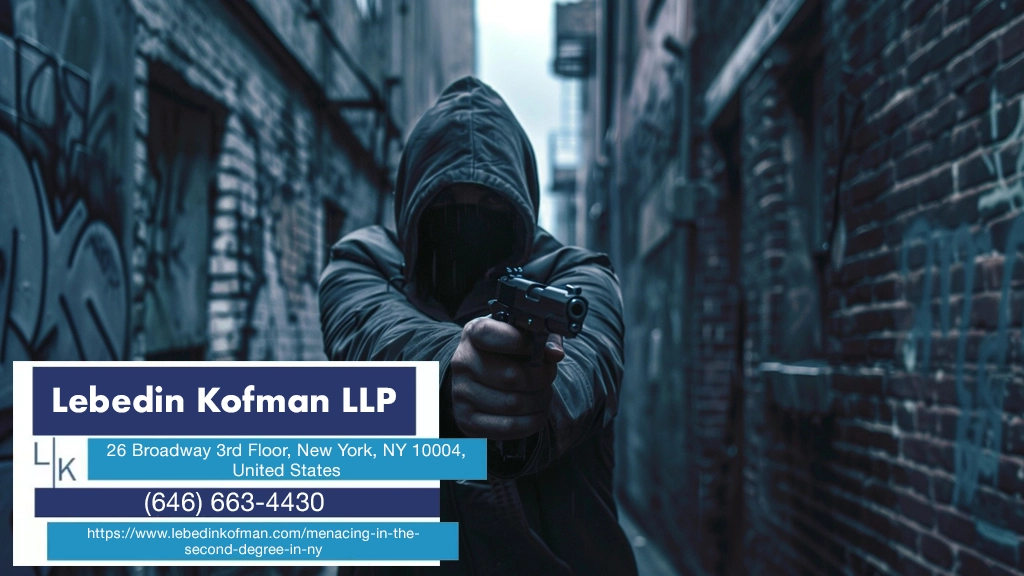Getting slapped with a menacing in the second degree charge can feel like getting hit by a freight train you never saw coming. One moment you’re having a heated argument, the next you’re staring at a Class A misdemeanor that could land you in jail for nearly a year. Trust me, I’ve seen this scenario play out more times than I care to count in courtrooms across New York and Long Island.
At Lebedin Kofman LLP, our New York criminal defense attorneys are dedicated to guiding clients through the complexities of menacing in the second degree charges with confidence and clarity. We understand how stressful and overwhelming these accusations can be, and we’re here to provide the strong legal support you need. Contact us today at (646) 663-4430 for a complimentary consultation.

Let’s break down what this charge really means and what you can do about it.
What Is Menacing in the Second Degree?
Under New York Penal Law § 120.14, menacing in the second degree kicks in when someone intentionally tries to make another person fear they’re about to get seriously hurt or killed. The law recognizes three distinct ways this can happen, and understanding these categories is crucial for mounting an effective defense.
The Three Paths to This Charge
Weapon Display: You intentionally put someone in fear by showing off a deadly weapon, dangerous instrument, or something that looks like a firearm. This includes everything from kitchen knives to realistic toy guns that could fool someone in the heat of the moment.
Stalking Behavior: You repeatedly follow someone or engage in a pattern of conduct that makes them reasonably fear for their safety. The key word here is “repeatedly”, this isn’t about one bad day, it’s about ongoing behavior that creates genuine fear.
Protection Order Violations: If you commit third-degree menacing against someone who has an order of protection against you, it automatically escalates to second degree. The courts take these violations seriously, and the penalties reflect that.
Breaking Down the Legal Elements
Prosecutors can’t just point fingers and hope for the best. They need to prove three critical elements beyond a reasonable doubt:
Intent: The Mental Game
The prosecution must show you acted with purpose. Your conscious objective was to cause fear or engage in conduct that would naturally cause fear. This isn’t about accidents or misunderstandings, it’s about deliberate action.
Here’s where things get interesting from a defense perspective. Intent can be tricky to prove. Just because someone got scared doesn’t mean you intended to scare them. Maybe you were defending yourself, or maybe your actions were taken out of context.
Reasonable Fear: The Victim’s Perspective
The alleged victim must have been placed in reasonable fear of physical injury, serious physical injury, or death. Notice that word “reasonable”, it’s doing a lot of heavy lifting here.
If someone claims they were terrified because you raised your voice, that’s probably not going to meet the reasonable standard. But if you were waving a baseball bat while yelling threats, that’s a different story entirely.
The Right Kind of Conduct
The behavior must involve either displaying a weapon or engaging in repeated intimidating acts. One angry outburst without weapons typically falls under third-degree menacing, not second degree.
Understanding Weapons and Dangerous Instruments
New York law gets pretty specific about what counts as a weapon, and these definitions can make or break your case.
Deadly weapons include the obvious suspects: firearms, certain knives, billy clubs, brass knuckles, and any instrument specifically designed to cause serious physical injury.
Dangerous instruments cast a wider net. This category includes any object that, given the circumstances, could readily cause serious injury or death. A hammer isn’t inherently a weapon, but if you’re brandishing it during a heated argument, it becomes a dangerous instrument under the law.
Physical injury means impairment of physical condition or substantial pain, while serious physical injury involves a substantial risk of death, actual death, or serious and lasting disfigurement or impairment.
Real-World Examples That Land People in Court
Let me paint some pictures of how these charges typically unfold:
The Kitchen Knife Incident: You’re arguing with your roommate about unpaid bills. Things escalate, and you grab a knife from the counter while telling them to “back off or else.” Even if you never intended to actually hurt anyone and never made physical contact, displaying that knife while making threats checks all the boxes for second-degree menacing.
The Ex-Partner Stalking Case: After a messy breakup, you start showing up at your ex’s workplace, following them to the grocery store, and parking outside their apartment building. After weeks of this behavior, they’re genuinely afraid for their safety. That pattern of conduct can land you a second-degree menacing charge, even without any weapons involved.
The Protection Order Violation: You have an order of protection against you, but you still send threatening text messages or show up at places you’re not supposed to be. Even behavior that would normally only be third-degree menacing gets bumped up to second degree when it violates a court order.
The Penalty Structure: What You’re Facing
Menacing in the second degree is classified as a Class A misdemeanor, which puts it at the top of the misdemeanor food chain. The potential consequences include:
- Up to 364 days in county jail
- Fines reaching $1,000
- Probation terms
- Community service requirements
- A permanent criminal record
That last point deserves special attention. New York doesn’t expunge criminal records like some other states do. This conviction becomes part of your permanent record, potentially affecting employment opportunities, housing applications, professional licensing, and countless other aspects of your life.
How This Compares to Other Menacing Charges
Understanding where second-degree menacing fits in the hierarchy of threats can help you grasp the seriousness of your situation:
Third-Degree Menacing (Class B Misdemeanor): Basic threatening behavior without weapons or stalking patterns. Maximum penalty of 90 days in jail.
Second-Degree Menacing (Class A Misdemeanor): Involves weapons, stalking, or protection order violations. Up to 364 days in jail.
First-Degree Menacing (Class E Felony): Second-degree menacing with aggravating factors like prior convictions or when the victim is a police officer. This can result in up to four years in prison.
Defense Strategies That Actually Work
Every case is unique, but here are the defense approaches I’ve successfully used:
Challenging Intent
Sometimes people react instinctively in stressful situations without any conscious intent to threaten. If we can show your actions were reflexive, defensive, or misinterpreted, we can challenge the intent element.
Questioning the Weapon Classification
Not everything that looks dangerous actually qualifies as a deadly weapon or dangerous instrument under New York law. If the object you allegedly displayed doesn’t meet the legal definition, we can get the charges reduced or dismissed.
Attacking the “Reasonable Fear” Element
Fear is subjective, but the law requires it to be reasonable. If the alleged victim’s reaction was disproportionate to your actions, or if their claimed fear doesn’t make sense given the circumstances, we can challenge this element.
Self-Defense Claims
If you displayed a weapon or acted threateningly because you reasonably believed you were about to be attacked, self-defense might apply. New York law allows people to protect themselves when facing imminent harm.
Constitutional Defenses
Sometimes these charges arise from situations involving free speech or other constitutional rights. While true threats aren’t protected speech, the line between protected expression and criminal threatening can be blurry.
The Prosecution’s Playbook
Understanding how prosecutors approach these cases helps us prepare better defenses. They typically focus on:
- The alleged victim’s testimony about their fear
- Physical evidence like weapons or threatening messages
- Witness testimony about the incident
- Any history between you and the alleged victim
- Video or audio recordings
Prosecutors love cases with clear documentation. Text messages, social media posts, surveillance video, and multiple witnesses make their job easier. When evidence is thin or contradictory, we have much more room to work.
Why These Cases Require Experienced Representation
I’ve seen too many people try to handle menacing charges on their own, thinking they can simply explain their side of the story. That approach rarely works out well.
These cases involve complex legal concepts, nuanced definitions, and prosecutors who know exactly what they’re doing. The difference between a good outcome and a terrible one often comes down to understanding the subtle legal distinctions and knowing how to leverage them effectively.
What experienced representation brings to your case:
Thorough Investigation: We examine every piece of evidence, interview witnesses, and look for inconsistencies in the prosecution’s case.
Strategic Negotiations: Sometimes the best outcome comes through plea negotiations rather than trial. Knowing when to fight and when to negotiate is crucial.
Trial Experience: If your case goes to trial, you want someone who knows how to present your story effectively and challenge the prosecution’s evidence.
Case Management: We handle all the legal paperwork, court appearances, and communication with prosecutors, allowing you to focus on maintaining your normal life.
Common Mistakes That Hurt Your Case
Let me share some mistakes I see people make that can seriously damage their cases:
Talking to Police Without a Lawyer: Anything you say can and will be used against you, even if you think you’re just explaining your side.
Contacting the Alleged Victim: This almost never helps and often makes things much worse. Even well-intentioned contact can be seen as witness intimidation.
Posting on Social Media: Prosecutors regularly check social media for evidence. That angry post about the situation could become Exhibit A.
Ignoring Court Dates: This turns a manageable situation into a much bigger problem with additional charges.
The Path Forward
Facing menacing charges feels overwhelming, but these cases are far from hopeless. With the right defense strategy, many result in reduced charges, dismissals, or acquittals at trial.
The key is acting quickly. Evidence disappears, witnesses forget details, and opportunities for favorable outcomes can vanish if you wait too long. The sooner we start working on your case, the better your chances of a positive result.
Protecting Your Future
A menacing conviction doesn’t just affect you today, it follows you for life. It can impact your career, your relationships, and your ability to move forward. That’s why fighting these charges isn’t just about avoiding jail time; it’s about protecting your entire future.
At Lebedin Kofman LLP, we understand what’s at stake. We’ve built our reputation by getting results when our clients need them most. Every case gets our full attention because we know that what might seem like just another file to someone else represents your life and your future.
Taking Action
If you’re facing menacing in the second degree charges in New York or Long Island, you don’t have to face this alone. These charges are serious, but they’re not the end of the world. With experienced legal representation, you can fight back and protect what matters most.
Remember, being charged doesn’t mean being convicted. The prosecution has to prove their case beyond a reasonable doubt, and there are often more defense options than you might realize. Don’t let one difficult situation define the rest of your life.
The most important step you can take right now is getting experienced legal help. These cases move quickly, and every day matters. Contact us today at (646) 663-4430 to start building your defense and protecting your future.
This article provides general information about hit and run laws in New York. Every case is unique, and you should consult with a qualified criminal defense attorney about your specific situation.

